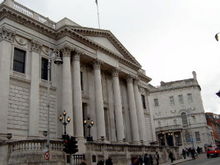
City Hall, Dublin
Encyclopedia


Ireland
Ireland is an island to the northwest of continental Europe. It is the third-largest island in Europe and the twentieth-largest island on Earth...
. It was built between 1769 and 1779 to the designs of architect Thomas Cooley
Thomas Cooley (architect)
Thomas Cooley was an English architect who came to Dublin from London after winning a competition for the design of Dublin's Royal Exchange in 1768. He built several public buildings in Dublin in the neoclassical style...
and is a notable example of 18th-century architecture
Architecture
Architecture is both the process and product of planning, designing and construction. Architectural works, in the material form of buildings, are often perceived as cultural and political symbols and as works of art...
in the city.
Overview
Located at the top of Parliament Street on the city's southern side, it stands next to Dublin CastleDublin Castle
Dublin Castle off Dame Street, Dublin, Ireland, was until 1922 the fortified seat of British rule in Ireland, and is now a major Irish government complex. Most of it dates from the 18th century, though a castle has stood on the site since the days of King John, the first Lord of Ireland...
, the centre of British government in Ireland until 1922. The street had been built in 1753, providing a continuation of Capel Street on the north bank of the Liffey, across the newly widened Essex Bridge, and so the exchange ended (and still ends) a long streetscape.
The large size and fine fittings of the Royal exchange, with carved capitals by Simon Vierpyl, and plasterwork by the leading stucco
Stucco
Stucco or render is a material made of an aggregate, a binder, and water. Stucco is applied wet and hardens to a very dense solid. It is used as decorative coating for walls and ceilings and as a sculptural and artistic material in architecture...
dore Charles Thorpe, reflect the standing and prestige of Dublin in the 18th Century. The neo-classical building contains a central entrance hall or Rotunda
Rotunda (architecture)
A rotunda is any building with a circular ground plan, sometimes covered by a dome. It can also refer to a round room within a building . The Pantheon in Rome is a famous rotunda. A Band Rotunda is a circular bandstand, usually with a dome...
, with a large dome supported by twelve columns which is surrounded by an ambulatory where the merchants strolled and discussed business meetings.
The function of the building was to provide a meeting place for Dublin's businessmen, where they could buy and sell goods and trade bills of exchange. It was also close to the then Customs House that stood on the site of today's Clarence Hotel, making it convenient for overseas merchants. The cost of building the exchange was met by the Irish parliament, and this is reflected by the initials "SPQH", standing for "Senatus PopulusQue Hibernicus", meaning "The senate and people of Ireland" (an Irish version of SPQR
SPQR
SPQR is an initialism from a Latin phrase, Senatus Populusque Romanus , referring to the government of the ancient Roman Republic, and used as an official emblem of the modern day comune of Rome...
).
City government had originally been located in the mediæval Tholsel on Thomas Street, one quarter of a mile to the west, and before that on the Thingmount, where Suffolk Street now runs. In the 18th century meetings were held in South William Street (formerly the Civic Museum).
In 1815 the metal ballustrade of the exchange fell, owing to the pressure against it by a crowd, which led to the death of nine people, with many more injured. This led to crowd restrictions in the building.
In the 1850s, the City Corporation
Dublin Corporation
Dublin Corporation , known by generations of Dubliners simply as The Corpo, is the former name given to the city government and its administrative organisation in Dublin between 1661 and 1 January 2002...
bought the Royal Exchange and converted it for use by city government. The changes included partitions around the ambulatory, the construction of a new staircase from the Rotunda to the upper floors and the sub-division of the vaults for storage. On the 30th September 1852 the Royal Exchange was renamed City Hall at the first meeting of Dublin City Council held there. A series of fresco
Fresco
Fresco is any of several related mural painting types, executed on plaster on walls or ceilings. The word fresco comes from the Greek word affresca which derives from the Latin word for "fresh". Frescoes first developed in the ancient world and continued to be popular through the Renaissance...
s was later added, representing the regions of Ireland.
Today
The building was restored to its 18th-century appearance at the beginning of the 21st century, and Dublin City Council has won awards for the conservation of this historic building.Most Dublin City Council staff are located in the relatively new and controversial
Brutalist architecture
Brutalist architecture is a style of architecture which flourished from the 1950s to the mid 1970s, spawned from the modernist architectural movement.-The term "brutalism":...
Civic Offices, built from 1979 on the site of a national monument, the Viking city foundations on Wood Quay
Wood Quay
Wood Quay is a riverside area of Dublin that was a site of Viking settlement. Dublin Corporation acquired Wood Quay gradually between 1950 and 1975, finally announcing that it would be the location of their new offices. Finds made during the initial excavation of the site led to a massive, but...
.
Dublin Corporation itself was renamed in the early 21st century as Dublin City Council
Dublin City Council
Dublin City Council is the local authority for the city of Dublin in Ireland. It has 52 members and is the largest local authority in Ireland. Until 2001, it was known as Dublin Corporation.-Legal status:...
, previously the name of the assembly of councillors only. Council meetings take place in City Hall.

